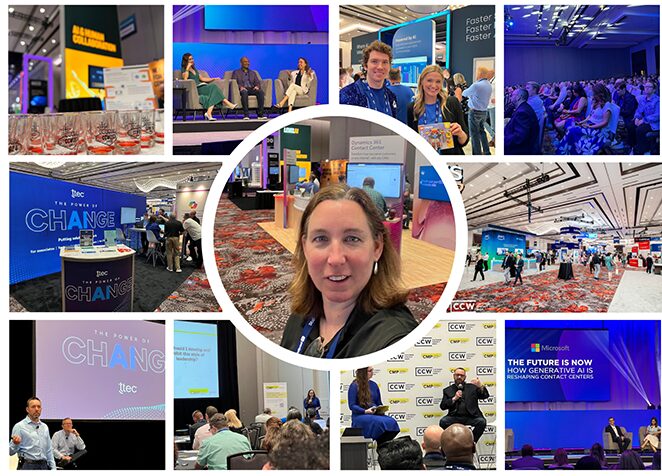During the dot com boom, I got my first real job at internetnews.com, reporting on new internet startups and how legacy brands tried to keep up with the new online world. There, I was introduced to trade shows by attending Internet World, a sprawling event where the enthusiasm and excitement was palpable for how the internet was changing the world in real time.
This year, I got a similar feeling at the recent Customer Contact Week conference, the popular annual gathering of contact center players in Las Vegas hosted by Customer Management Practice. The show — its largest to date — featured two expo halls full of AI and other tech vendors touting their digital wares. Meanwhile, nearly 5,000 attendees included many contact center practitioners looking to stay on top of the changing industry.
The yin and yang of people and technology was on full display. Conversations volleyed between AI and data analysis to mental health and employee burnout. Last year’s fear and skepticism about AI on the show floor was replaced with an urgency to understand which tools are best suited for a variety of contact center challenges.
The one question on everyone’s mind, as it was at Internet World decades ago: “How do I integrate technology to innovate without damaging my brand, customer, or employee experience?”
Nicole Kyle, managing director of CMP Research, said it’s a question of managing digital dexterity for brands and customers. Digital experiences have been normalized by consumers across all industries, and expectations are high for AI and other digital tools to support internal and external operations. Companies are still hesitant to take big steps, however.
“Inertia is in the industry generally,” Kyle said, but data shows companies can’t afford to wait. Only 7% of consumers feel experiences have gotten much better over the past year, while 55% say they have gotten worse, according to CCW Digital’s 2024 June Market Study.
Like in the internet’s nascent days, there’s no one proven path. “When everyone [in the vendor space] does everything, it’s hard to know where to start,” said James Bednar, head of product at TTEC, during a thought leadership session. Adaptability and flexibility are critical to the CX industry’s evolution, especially as the theory of AI outshines its current practical impact, he added.
“Experiences may not be human to human, but they have to feel human to human.”
Nick Cerise, Chief Marketing Officer, TTEC
For example, Kyle presented data from the new report, “2024-2025 Customer Contact Benchmarking Report,” which found that a majority of consumers are theoretically willing to use chatbots for self-service, but the current reality doesn’t match the vision. Only 17% are confident they can successfully address a service issue with a chatbot.
Balance humanity with technology
Low confidence levels in AI come from uncertainty when humans are not present in the interaction. Discussions at the show focused on balancing technology with humans and knowing when to lean into AI and when to lead with a human touch. Technology alone is not the answer.
“We don’t view automation as being bad,” said Bednar. “A lot matters in the quality of the implementation, with time and effort to get the most out of [the technology].” For customers, he said, use automation and AI tools to reduce friction and escalate to humans quicker with context.
This aligns with new CMP research that cited “creating a frictionless customer experience” as the top priority among global customer contact and CX leaders.
Frictionless doesn’t mean completely automated or completely human. Find the balance that works for unique customer journeys, said TTEC Chief Marketing Officer Nick Cerise.
“Experiences may not be human to human, but they have to feel human to human,” he said.
Leadership lessons from Las Vegas
Besides technology conversations, attendees were hungry for insight on how to engage employees and lead when employees don’t share the same space. Kyle and her colleagues shared research showing that only 11% of contact center employees work on site, compared to 76% before COVID. As a result, engaging and retraining associates is a top leadership priority.
“Even if people don’t say it, they yearn for connection,” added Mark Killick, senior vice president of experience operations for logistics company Shipt, in a conversation with Kyle.
Contact center employees are understandably uneasy about the industry’s uncertain future. They are dealing with more complex calls, unhappy customers, and adopting new tech. Mental health awareness and burnout are challenges that shouldn’t be ignored.
“Even if people don’t say it, they yearn for connection.”
Mark Killick, senior vice president of experience operations, Shipt
Today’s leaders must create deeper, more authentic, and supportive relationships with employees to manage AI’s disruption without jeopardizing their engagement, Kyle said during a leadership workshop. She shared seven competencies for effective CX leaders:
- Stability
- Autonomy
- Emotional intelligence
- 360-degree coaching
- Mindfulness
- Leadership
- Functional expertise
In a snap poll, most attendees said they felt most confident in their functional expertise, and least confident in their autonomy to trust themselves and their teams to produce good work without micro-managing. That’s backed by CMP research data — only 6% of contact centers grant associates freedom to go off-script and provide “above and beyond” care.
“Leaders need to create space for employees, to help them to see where AI and new technology changes work for the better,” Kyle said.
My overall takeaway from the show was that the CX industry is vibrant and energized about the shift taking place. CX leaders are beginning to show some digital dexterity and are taking steps to balance humans and technology with AI implementations to improve associate work and gain deeper customer insights.
There’s a lot to be optimistic about for the future, even if it’s not yet fully defined, according to Amber Scott, vice president of CX at Serta Simmons Bedding.
“I think there will be space in CX for anyone who wants to be in CX, it will just look different.”

